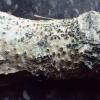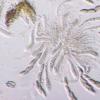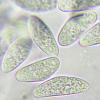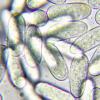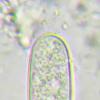
17-10-2025 18:45
 Riet van Oosten
Riet van Oosten
Hello, Found by Laurens van der Linde, Oct. 2025.

23-09-2025 13:31
Thomas Læssøehttps://svampe.databasen.org/observations/10534623

15-10-2025 16:39
 Edvin Johannesen
Edvin Johannesen
These tiny (0.2-0.6 mm), white, pulvinate apotheci

03-10-2025 13:44
 Riet van Oosten
Riet van Oosten
Hello, Found by Laurens van der Linde on Populus

13-10-2025 19:05
Louis DENYBonjour forumSur tronc décortiqué de feuillu x,

11-10-2025 20:27
 Marcel Heyligen
Marcel Heyligen
Found on a barked branch, 14 mm in diameter, of Ro

09-10-2025 22:14
S. RebeccaWe just had the Bavarian Mycology Conference in Au

10-10-2025 00:49
Ethan CrensonHello all, This was found last weekend on a hardw
Diplodia-like
Bernard Declercq,
10-11-2023 17:11
 Hello,
Hello,Collected on a fallen corticated branch of Populus x canadensis:
Ascomata and conidiomata occurring separately in the same stroma, partially erumpent, multiloculate, up to 1.5 mm diam., black.
Asci fissitunicate, elongate clavate,(4)8-spored, e.g. 150x25 µm, tapering stalk. Ascospores ellipsoid to rhomboid, inequilateral, with broadly rounded ends, aseptate, thick-walled, granular contents, hyaline, 26-37x14-16 µm (8-spored asci) or 31-48x15-19 µm (4-spored asci).
Conidiophores reduced to conidiogenous cells. Conidiogenous cells monoblastic, cylindrical to narrowly clavate, 10-15x5-6 µm, hyaline. Conidia cylindrical, 29-34x12-14 µm, with broadly rounded ends, aseptate, granular, without mucoid sheath, hyaline.
I know Diplodia and similar are not the most easy ones, but I hope someone can help me.
Thanks in advance.
Bernard
Alain GARDIENNET,
11-11-2023 11:09
Re : Diplodia-like
Salut Bernard,
Voilà longtemps de je n'ai pas regardé ces groupes là, et je ne sais pas où en sont les études, mais ça me fait penser à un Botryosphaeria. Les mesures sporales que tu donnes se rapprochent de celles de B; quercuum. Je te laisse aller plus loin.
Alain
Voilà longtemps de je n'ai pas regardé ces groupes là, et je ne sais pas où en sont les études, mais ça me fait penser à un Botryosphaeria. Les mesures sporales que tu donnes se rapprochent de celles de B; quercuum. Je te laisse aller plus loin.
Alain
Bernard Declercq,
11-11-2023 13:01

Re : Diplodia-like
Salut Alain,
Merci pour ta réponse.
En effet, se basant sur la forme, la guttulation et les dimensions des ascospores, Botryosphaeria quercuum ainsi que Melanops tulasnei pouraient convenir.
Mais j'ai du exclure ces deux espèces se basant sur les conidies:
B. quercuum a des conidies subgloboses 18-25x12-16 µm, tandis que M. tulasnei a des conidies fusiformes 41-53x9-11 µm (selon Sivanesan 1983: fig. 67 & 70).
Bernard
Merci pour ta réponse.
En effet, se basant sur la forme, la guttulation et les dimensions des ascospores, Botryosphaeria quercuum ainsi que Melanops tulasnei pouraient convenir.
Mais j'ai du exclure ces deux espèces se basant sur les conidies:
B. quercuum a des conidies subgloboses 18-25x12-16 µm, tandis que M. tulasnei a des conidies fusiformes 41-53x9-11 µm (selon Sivanesan 1983: fig. 67 & 70).
Bernard

